Today we are on a new topic of Enable or Disable Default Cookies Setting Policy in MS Edge Browser using M365 Admin Center. As you all know about the Microsoft 365 policies and it’s benefits. We have recently published many Policies for Microsoft Edge.
You know it is the crucial platform to deploy policies on Microsoft Edge. You know Cookies are very important, and it acts as a small file that websites save on your device to remember your preferences, login details, or browsing activity. Managing cookies in Microsoft Edge is important for controlling how websites store data on your device.
The cookie control policy in Microsoft Edge gives users the ability to choose whether websites can save cookies on their devices. It operates on an all-or-nothing basis, meaning users can either allow all websites to save cookies or block all websites from doing.
However, this policy does not offer the option to enable cookies for specific websites, which simplifies cookie management but limits customization for individual site preferences. In this post Let’s discuss how this policy configured to Microsoft Edge.
Table of Contents
How can you Control Cookie Creation on a User’s Device in Microsoft Edge?
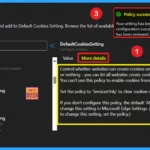
You can either allow all websites to create cookies or block all cookies with this policy. Setting it to ‘SessionOnly’ clears cookies when the session ends. If not configured, the default ‘AllowCookies’ setting applies, and users can change it unless you set the policy to prevent changes
Default Cookies Setting Policy in MS Edge Browser using M365 Admin Center
Above we discussed a lot of things in Cookie’s settings. Now we get into the important part of how this policy is deployed through the Microsoft 365 admin center. For that first you have to sign into the Microsoft 365 admin center. Then navigate through Settings> Microsoft Edge> Configuration Settings> Create.
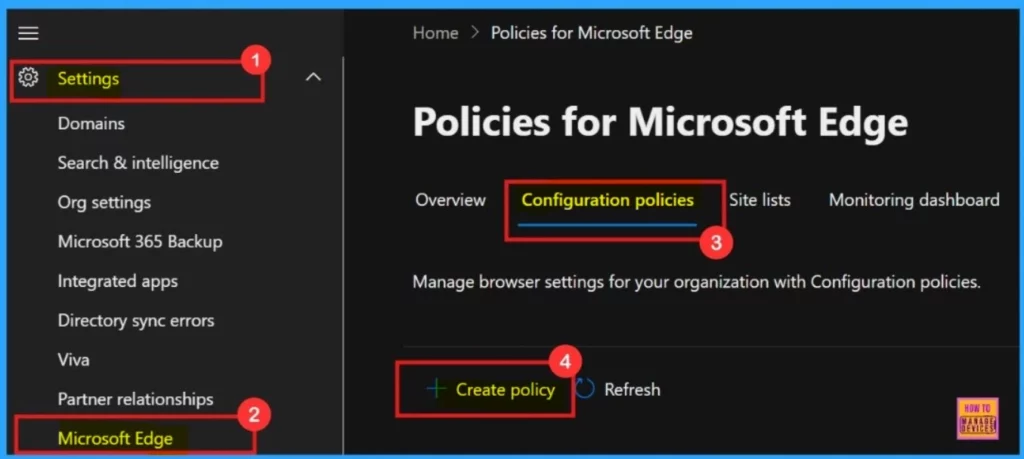
- Enable or Disable Full Screen Mode Policy in Edge Browser using Microsoft 365 Admin Center Policy
- Enable Autofill for Addresses in MS Edge Browser using Microsoft 365 Admin Center Policy
- Enable Disable Deleting Browser History in Edge using the Microsoft 365 Admin Center Policy
Basics
Then we entered the First configuration Setting step that is Basics. In basics we have to enter the basic details such as the policy Name, Description etc. Then you have to click on the Next for further steps.
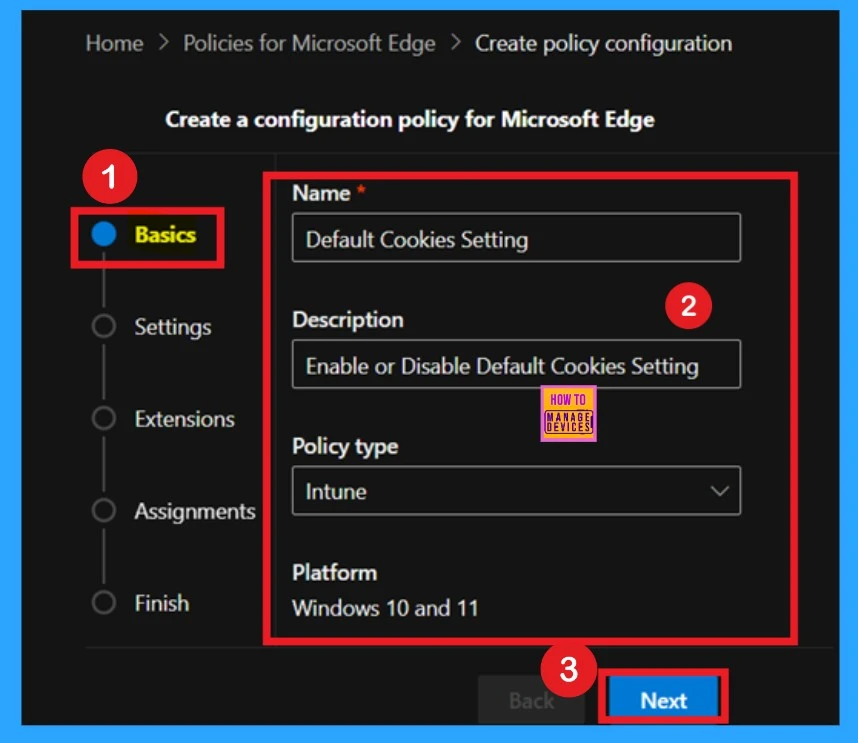
Settings
The next crucial part is Settings. In settings we have to enable or disable options for those settings. First in the Settings step you have to click on the + Add setting option or Add settings.
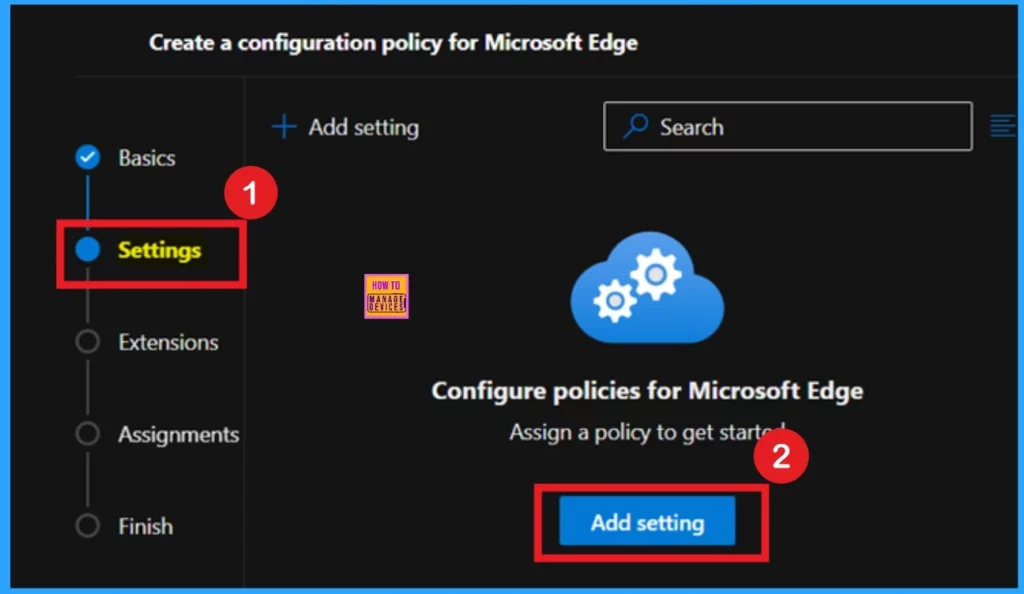
When you click Add Settings, you’ll be taken to the Configuration settings page. The first step is to select the policy name by using the search option. Once you find the required configuration policy, click on it. The selected policy will appear under two tabs: Value and More details. Under the Value tab, you’ll see three available options.
- Let all sites create cookies.
- Don’t let any site create cookies.
- Keep cookies for the duration of the session, except ones listed in “SaveCookiesOnExit”.
- Here I selected Let all sites create cookies.
- Then click on the Select
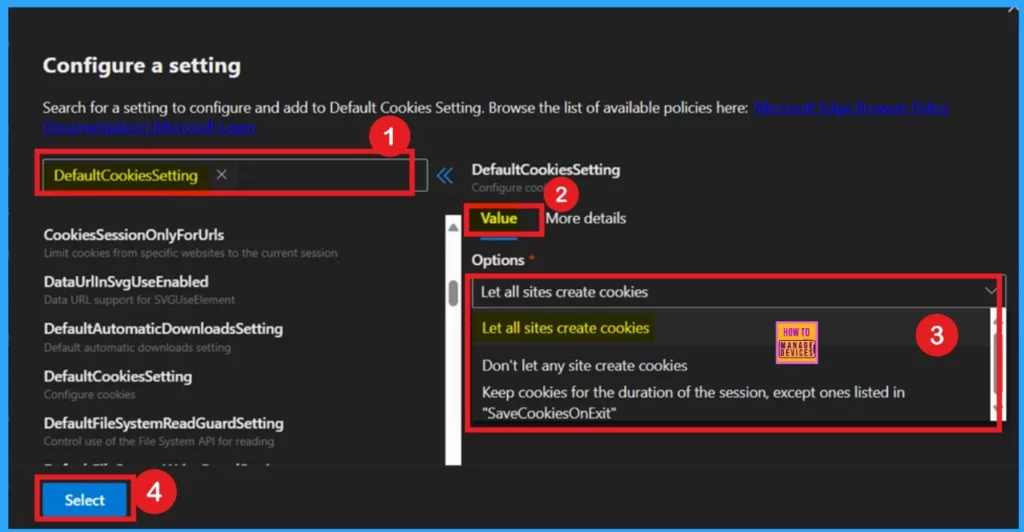
Now you’re on the More details tab, which is more user-friendly and informative. It provides additional insights about the selected policy, helping users better understand its purpose and impact. For example, it may describe the policy as: “Control whether websites can create cookies on the user’s device.” This particular setting is an all-or-nothing policy—either all websites are allowed to create cookies, or none are.
- You can’t use this policy to enable cookies from specific websites.
| More Details |
|---|
| Control whether websites can create cookies on the user’s device. This policy is all or nothing – you can let all websites create cookies, or no websites create cookies. You can’t use this policy to enable cookies from specific websites. Set the policy to ‘SessionOnly’ to clear cookies when the session closes. If you don’t configure this policy, the default ‘AllowCookies’ is used, and users can change this setting in Microsoft Edge Settings. (If you don’t want users to be able to change this setting, set the policy.) |
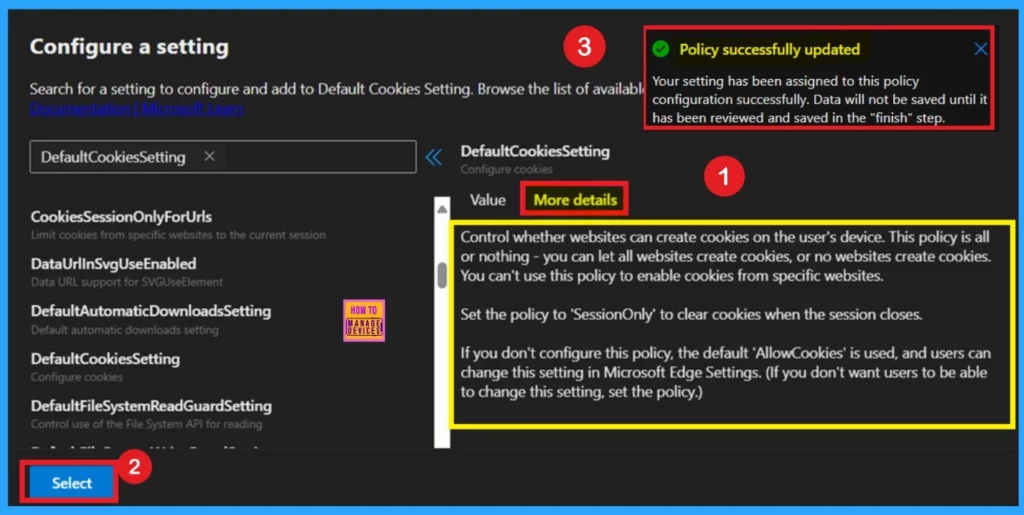
Extensions
In the Extensions section, you can manage extension behaviors based on policies, such as installation preferences, permissions etc. To add a specific extension to your policy, click the + Add extension button. If no additional settings are required for an extension, just click Next to proceed.
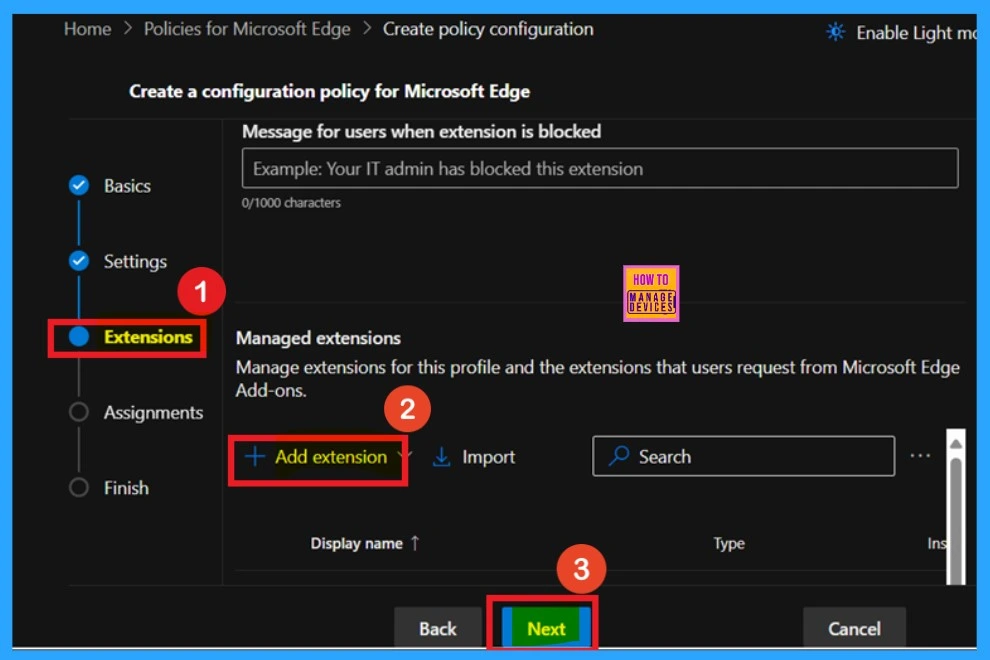
Assignments
The Assignments tab, which is the 4th step in configuring your policy, enables you to specify which users, groups, or devices should receive the policy. To assign it, click +Select group. Choose the desired group from the available Microsoft Entra groups. For example, here I select Test_HTMD_Policy. After selecting the group, click Select.
- After selecting a group from the Microsoft Entra directory, you will receive a notification confirming that the group assignment has been successfully updated.
- Then click on the Next.
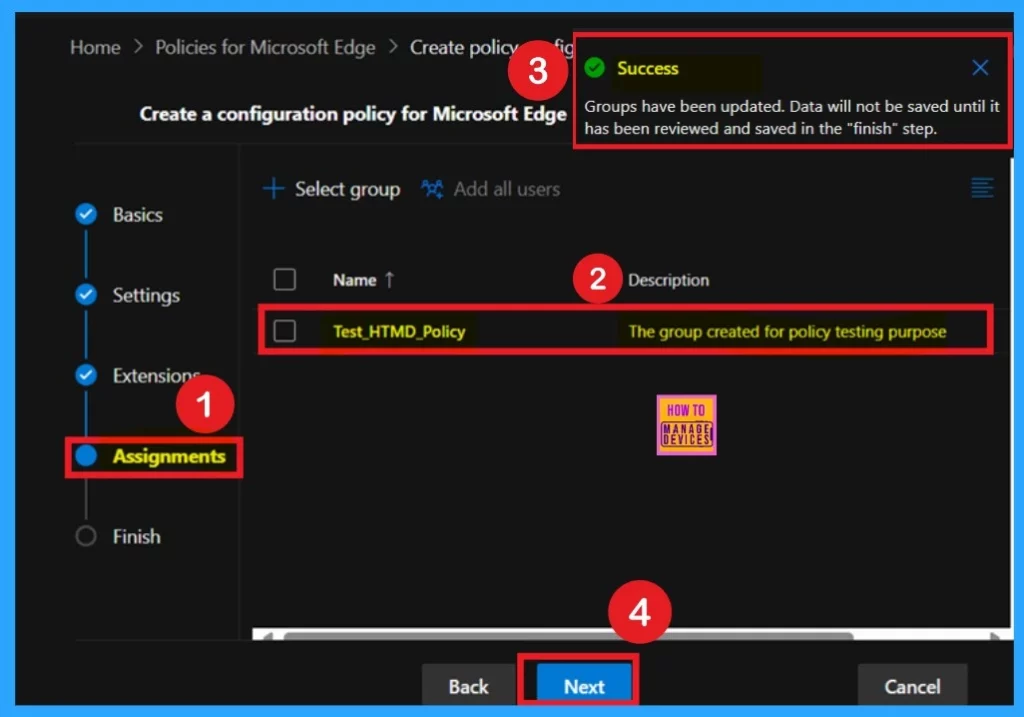
Review + Create
The Finish stage is the final step in the policy creation process, where you can review all previous settings. If needed, use the Back button to make changes. Once you’re sure everything is correct, click Review and Create to complete the process.
- A notification will confirm that the policy has been successfully created.
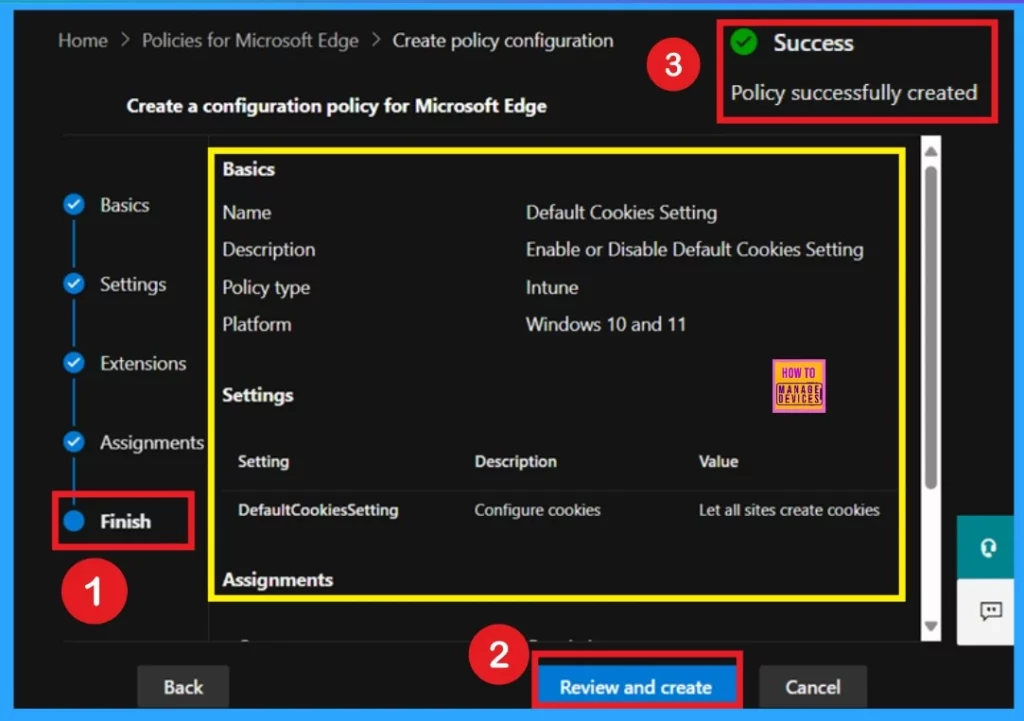
Monitoring Status
After manually syncing via the Company Portal, you can confirm the policy deployment in the Intune Portal. Go to Devices > Configuration, then check the Policies tab for the policy. A Successful status indicates that the policy was applied correctly to the device.

Client Side Verification
Administrators can check policy status on individual devices using Windows Event Viewer. To verify client-side compliance, go to Applications and Services Logs > Microsoft > Windows > DeviceManagement-Enterprise-Diagnostics-Provider > Admin, and then filter for Event ID 814.
| Policy Details |
|---|
| MDM PolicyManager: Set policy string, Policy: (DefaultPopupsSetting), Area: (microsoft_edge~Policy~microsoft_edge~ContentSettings), EnrollmentID requesting merge: (B1E9301C-8666-412A-BA2F-3BF8A55BFA62), Current User: (Device), String: (), Enrollment Type: (0x6), Scope: (0x0). |
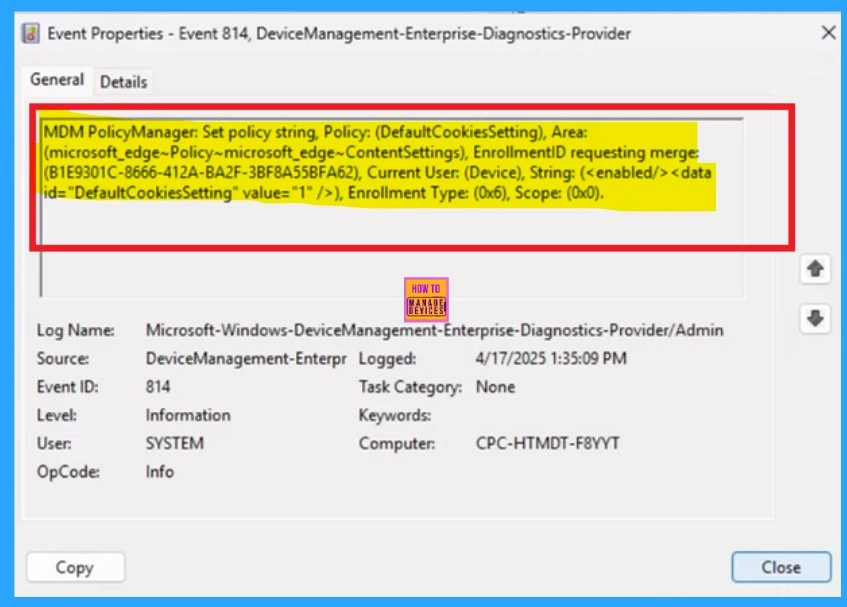
Before Default Cookies Setting Policy Configuration
Before configuring or delete the policy the user may experiance thge Edge settings for Cookies Setting is just like the screenshot. It can be Enabled or disabled by the user. You can check the changes in the End user Experience below after the policy Configuration.

End User Experience
In the result you can check this on your Microsoft Edge settings by clicking on the 3 dots. In the settings you will get the Cookies settings in the Cookies and site permission tab. When you click on that you will get Allow sites to save and read cookie data (recommended) that is enabled by default.
Note: The option Allow sites to save and read cookie data (recommended) is Enabled by the policy and it can’t be disabled by the user.

Need Further Assistance or Have Technical Questions?
Join the LinkedIn Page and Telegram group to get the latest step-by-step guides and news updates. Join our Meetup Page to participate in User group meetings. Also, Join the WhatsApp Community to get the latest news on Microsoft Technologies. We are there on Reddit as well.
Author
Anoop C Nair has been a Microsoft MVP for 10 consecutive years from 2015 onwards. He is a Workplace Solution Architect with more than 22+ years of experience in Workplace technologies. He is a Blogger, Speaker, and Local User Group Community leader. His primary focus is on Device Management technologies like SCCM and Intune. He writes about technologies like Intune, SCCM, Windows, Cloud PC, Windows, Entra, Microsoft Security, Career, etc.
